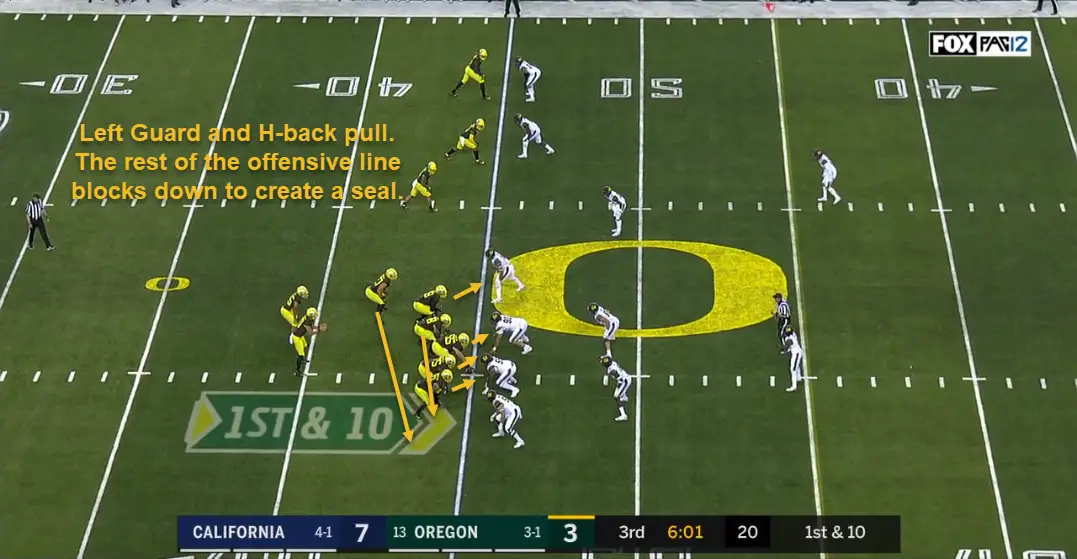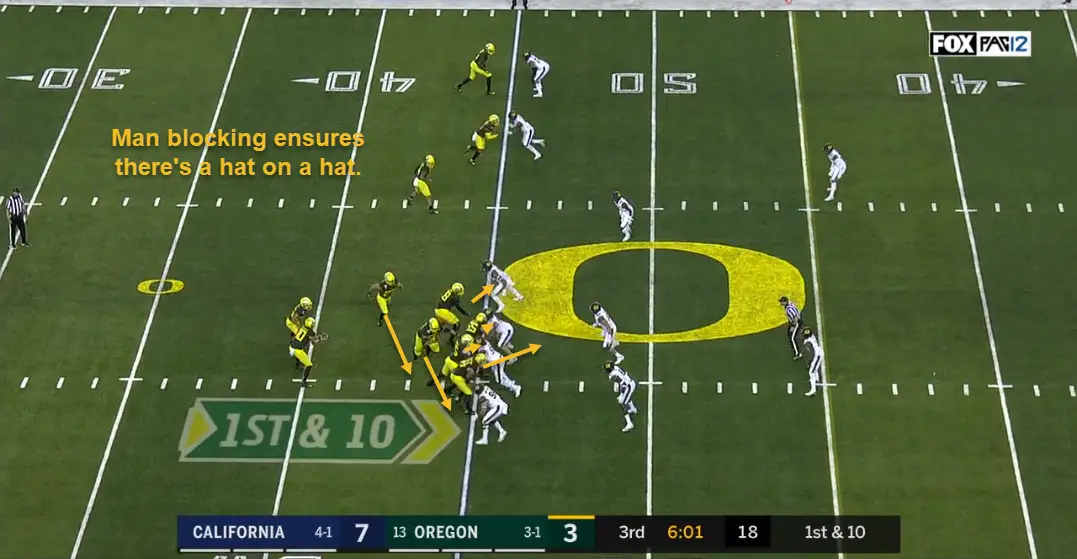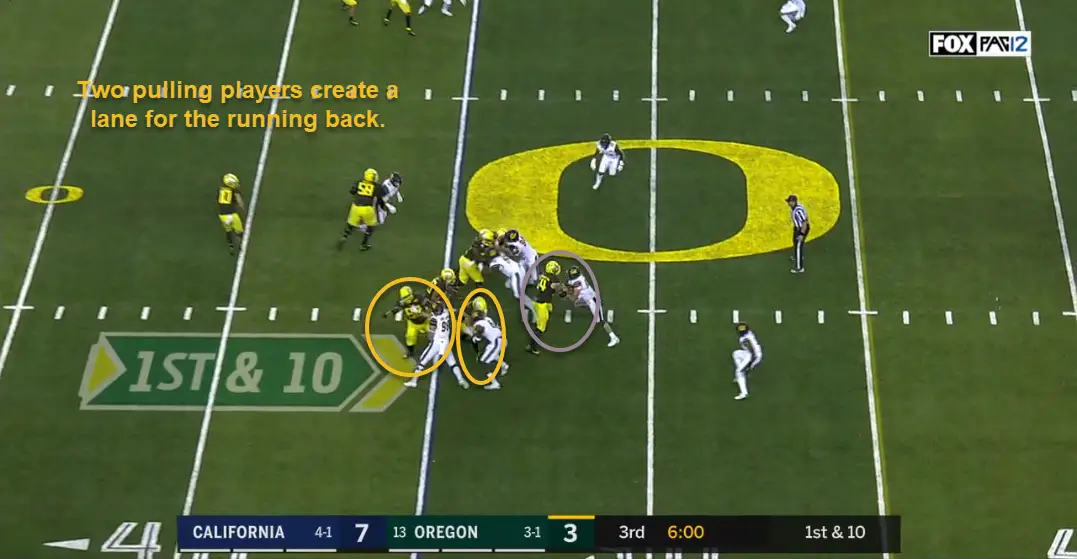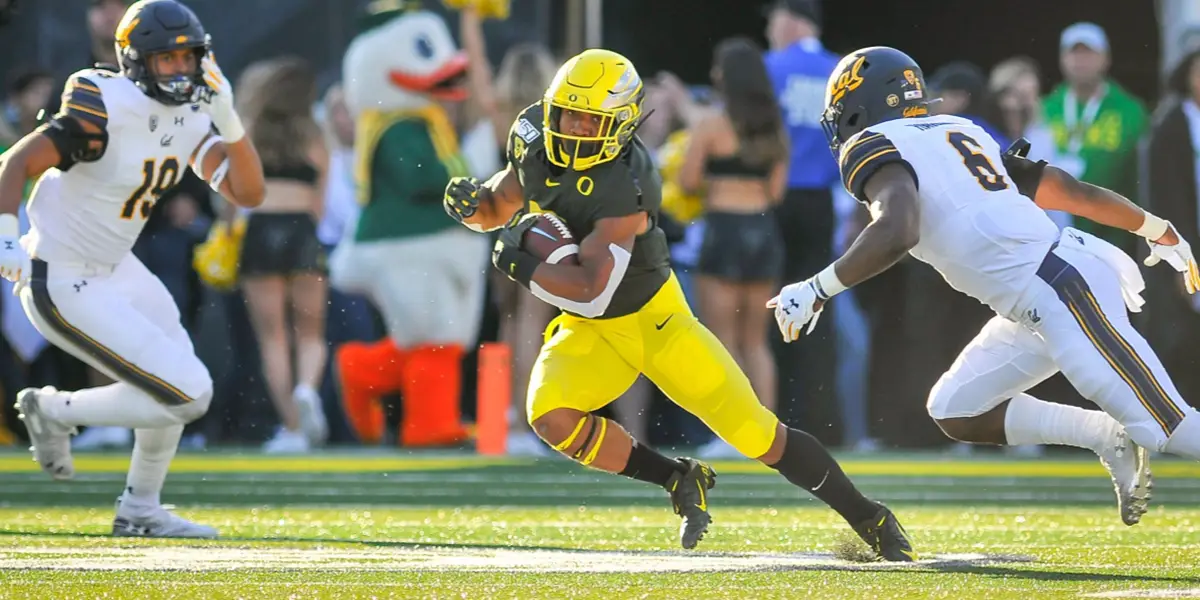No one’s going to confuse Oregon offensive coordinator Marcus Arroyo for Oklahoma wunderkind Lincoln Riley.
The latter is arguably the brightest offensive mind football right now, and his offense is once again lighting up the scoreboard this season. The same can’t be said about Arroyo, whose offense has struggled at times to live up to the lofty expectations of highlight-starved Oregon fans.
But Arroyo has the Ducks’ offense on the right track, taking some notes from the Sooners’ head coach extraordinaire.
Against Cal, the Ducks ran a play that Oklahoma centers its explosive rushing offense around: the Counter. The counter is an old-school running play that uses man blocking to get a “hat on a hat” in the running game.
This was a change-up, as Oregon typically uses zone blocking, which relies on blocking an area or a zone rather than a designated defender. While zone blocking has its perks, the best rushing offenses mix man- and zone-blocking concepts to keep defenses off guard.

The counter
The above picture diagrams how the counter play is blocked. As mentioned, the counter is a man-blocking play, which means that each blocker is assigned a defender to block. The counter play uses two pullers: blockers who pull across the formation to block their designated defenders. The majority of the blockers down block, essentially blocking the man in front of them. The pullers come across the formation to block the remaining unblocked defenders on the playside.
This play, when executed properly, creates a big seal for the running back to run through.

The counter in motion
Above, the play begins to develop. The two pullers run across the formation while the rest of the linemen block their designated men.

A perfectly blocked counter
In the photo above, the two pullers (circled in yellow above) have sealed off their defenders. Meanwhile, right tackle Calvin Throckmorton (No. 54, circled in purple above) does a good job of sealing off his defender in his down block. The result is a perfect lane for running back Travis Dye (No. 26) to run through.
Riley and Oklahoma run the counter extensively, and the Sooners’ effectiveness in running it is one of the biggest reasons their offense is so successful. Because of the massive, easy-to-identify running lane the play creates, it has the potential to pay off in a big way for the Ducks, too.
People have complained about the lack of explosiveness in the Oregon running game. With the counter, even young, inexperienced running backs can spot the wide open holes that it produces, and the Ducks’ big and powerful offensive line should maul defenders in man-blocking situations.
Furthermore, there are loads of sequential and constraint plays that can be run off of the counter. For example, in the same game against Cal, Oregon ran a fake counter, running back flare screen.
This play (above) is successful because of the counter motion (the pulling left tackle and left guard). The defense thinks that it’s a run, but it’s actually a flare screen to the running back, who escapes out of the backfield at the last second. The linebackers bite on the counter look, and it’s an easy first down for the Ducks.
The Ducks’ offense isn’t at Oklahoma’s level yet, but it’s showing signs of the creativity that the fan base has so desperately clamored for. The counter play and the sequential plays that can be run off of it are great additions to the Oregon offense, and if the Ducks continue to run them, the offense will begin to resemble the high-scoring units of yesteryear.
Joshua Whitted
Morgantown, West VirginiaTop Photo by Kevin Cline
 Bob Rodes, the FishDuck.com Volunteer editor for this article, is an IT analyst, software developer and amateur classical pianist in Manchester, Tennessee.
Bob Rodes, the FishDuck.com Volunteer editor for this article, is an IT analyst, software developer and amateur classical pianist in Manchester, Tennessee.
Joshua is an adopted Duck fanatic, originally hailing from southwestern Pennsylvania. His love for the University of Oregon began as a young child when he became mesmerized by the flashy uniforms and explosive offenses of the Chip Kelly era, and now, he follows the team religiously. His fondest memory of the team is seeing De’Anthony Thomas race past Wisconsin defenders back in the 2012 Rose Bowl. A true football enthusiast, Joshua loves studying the intricacies of the game, and he aspires to become a professional sports journalist. Joshua now resides in Morgantown, West Virginia where he works in customer service. When he’s not watching Oregon replays, Joshua loves reading, writing, and spending time with his family. Contact: whittedjd@gmail.com

